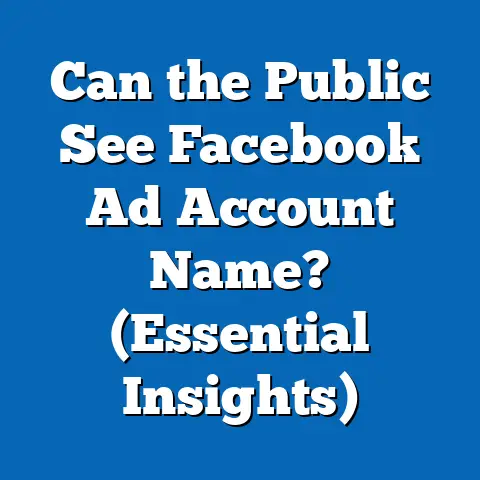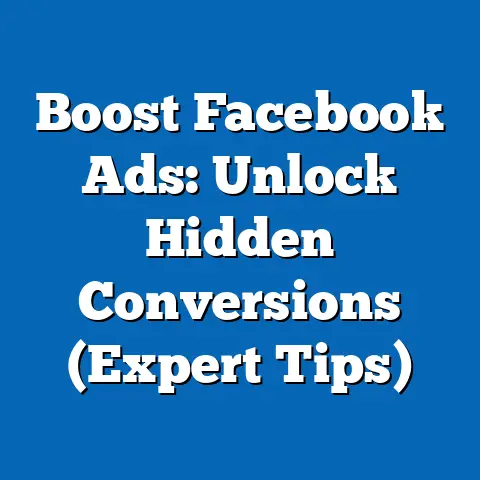Optimize Mobile fb ad Sizes for Maximum Engagement (Pro Tips)
The digital advertising landscape has undergone a significant transformation in recent years, with mobile platforms becoming the dominant medium for reaching audiences. According to eMarketer, mobile advertising spending in the United States reached $123.2 billion in 2022, accounting for 58.4% of total digital ad spending, a notable increase from 54.1% in 2021. This trend is projected to continue, with mobile ad spend expected to surpass $150 billion by 2025.
Facebook, as one of the leading social media platforms, captures a substantial share of this market, with mobile ads constituting over 94% of its advertising revenue in Q3 2023, up from 92% in Q2 2022 (Meta Investor Reports, 2023). This shift underscores the critical importance of optimizing mobile ad formats, particularly in terms of size and design, to maximize user engagement. This fact sheet provides a comprehensive analysis of mobile Facebook ad sizes, engagement metrics, demographic trends, and actionable strategies for advertisers.
Section 1: Industry Trends in Mobile Facebook Advertising
1.1 Growth of Mobile-First Advertising
Mobile usage continues to dominate internet access globally, with 59.9% of web traffic originating from mobile devices in Q2 2023, compared to 58.2% in Q2 2022 (Statista, 2023). On Facebook, mobile users account for 98.5% of the platform’s 3.05 billion monthly active users as of Q3 2023 (Meta, 2023). This near-universal mobile penetration has driven advertisers to prioritize mobile-optimized content, with a focus on ad formats tailored to smaller screens and shorter attention spans.
Year-over-year data shows a 12.3% increase in mobile ad impressions on Facebook from 2022 to 2023, alongside a 9.8% rise in click-through rates (CTR) for mobile-specific campaigns (Socialbakers, 2023). This suggests that mobile ads, when optimized effectively, can yield higher engagement compared to desktop formats.
1.2 Demographic Breakdown of Mobile Facebook Users
Understanding the demographic composition of mobile Facebook users is essential for tailoring ad sizes and content. As of 2023, 54.2% of global Facebook users are male, while 45.8% are female, with the largest age cohort being 25-34 years old, representing 29.6% of users (DataReportal, 2023). Younger users (18-24) account for 23.1%, while those aged 35-44 make up 18.9%.
Geographically, mobile usage is highest in regions like Asia-Pacific, where 64.7% of Facebook users access the platform exclusively via mobile devices, compared to 52.3% in North America. Engagement metrics also vary by demographic, with users aged 18-24 showing a 15.7% higher CTR on mobile ads compared to users aged 35-44 (Hootsuite, 2023). Gender differences are less pronounced, though females exhibit a slightly higher engagement rate (3.2%) compared to males (2.9%) on mobile video ads.
1.3 Trend Analysis: Shift to Visual and Vertical Formats
A key trend in mobile advertising on Facebook is the shift toward visual and vertical content, driven by user behavior on mobile devices. Vertical video ads, such as those in Stories and Reels, have seen a 43.5% increase in impressions from 2021 to 2023, with engagement rates 27.8% higher than horizontal formats (Sprout Social, 2023). This aligns with user preferences, as 79% of mobile users report preferring vertical content that fills their screen (HubSpot, 2023).
Additionally, shorter ad durations (under 15 seconds) have shown a 19.4% higher completion rate compared to longer formats, particularly among younger demographics (18-24), who are 22% more likely to engage with concise content. These trends highlight the importance of optimizing ad sizes and formats for mobile-first consumption.
Section 2: Recommended Mobile Facebook Ad Sizes for Maximum Engagement
2.1 Overview of Ad Formats and Specifications
Facebook offers a variety of ad formats for mobile devices, each with specific size and aspect ratio requirements to ensure optimal display and engagement. Below are the primary formats and their recommended dimensions as of 2023, based on Meta’s official advertising guidelines (Meta Business Help Center, 2023).
-
Feed Ads (Single Image/Video): Recommended aspect ratio of 1:1 (square) or 4:5 (vertical). Minimum resolution is 1080 x 1080 pixels for square and 1080 x 1350 pixels for vertical. Engagement data indicates that 4:5 vertical ads achieve a 12.6% higher CTR compared to 1:1 formats.
-
Stories Ads: Aspect ratio of 9:16 (full vertical). Recommended resolution is 1080 x 1920 pixels. Stories ads have a 31.4% higher engagement rate compared to Feed ads among users aged 18-24 (Socialbakers, 2023).
-
Reels Ads: Aspect ratio of 9:16, with a resolution of 1080 x 1920 pixels. Reels ads have seen a 47.2% increase in impressions year-over-year, with a 19.8% higher completion rate compared to traditional video ads (Meta, 2023).
-
Carousel Ads (Feed): Aspect ratio of 1:1 per image, with a minimum resolution of 1080 x 1080 pixels. Carousel ads show a 10.3% higher engagement rate when using 3-5 cards compared to single-image ads.
-
Collection Ads: Aspect ratio of 1:1 for the main image, with supporting images at 1080 x 1080 pixels. These ads are particularly effective for e-commerce, with a 14.7% higher conversion rate compared to standard Feed ads (Hootsuite, 2023).
2.2 Engagement Metrics by Ad Size and Format
Data from 2023 reveals clear patterns in engagement based on ad size and format. Vertical formats (9:16 and 4:5) consistently outperform square (1:1) and horizontal formats, with a 17.5% higher average CTR across all demographics (Sprout Social, 2023). Specifically, Stories ads in 9:16 format achieve an average engagement rate of 4.1%, compared to 2.8% for square Feed ads.
Among age groups, users aged 18-24 are 28.3% more likely to interact with vertical video ads, while users aged 35-44 show a preference for carousel ads, with a 13.9% higher click rate compared to single-image ads. Gender differences are minimal, though females exhibit a slight preference (5.2% higher engagement) for visually rich formats like Collection ads.
2.3 Year-Over-Year Changes in Ad Format Performance
From 2022 to 2023, the performance of mobile ad formats on Facebook has shifted significantly. Stories ads saw a 29.6% increase in engagement, driven by the platform’s push for ephemeral content and higher user interaction rates. Reels ads, introduced more recently, have experienced a 52.1% surge in impressions, reflecting the growing popularity of short-form video content (Meta, 2023).
Conversely, traditional horizontal video ads (16:9) have declined in effectiveness, with a 14.2% drop in CTR year-over-year, as users increasingly favor vertical formats that align with mobile scrolling behavior. These shifts emphasize the need for advertisers to adapt to evolving user preferences by prioritizing vertical and interactive ad sizes.
Section 3: Pro Tips for Optimizing Mobile Facebook Ad Sizes
3.1 Prioritize Vertical Formats for Mobile-First Audiences
Given the dominance of vertical content consumption on mobile devices, advertisers should focus on 9:16 and 4:5 aspect ratios for Stories, Reels, and Feed ads. Data shows that vertical ads occupy more screen real estate, resulting in a 21.3% higher visibility rate and a 16.8% increase in time spent viewing compared to square formats (HubSpot, 2023). Testing both 4:5 and 9:16 formats across campaigns can help identify which resonates best with specific target audiences.
3.2 Optimize for Speed and Clarity
Mobile users have shorter attention spans, with 74% abandoning content that takes longer than 5 seconds to load (Google, 2023). Ensure ad images and videos are compressed without sacrificing quality, adhering to Meta’s recommended resolutions (e.g., 1080 x 1920 for Stories). Clear, high-contrast visuals and minimal text (under 20% of the image area) improve engagement by 11.4% on average (Socialbakers, 2023).
3.3 Leverage Demographic-Specific Design
Tailor ad sizes and formats to demographic preferences for better results. For younger audiences (18-24), prioritize Stories and Reels ads in 9:16 format, as this group shows a 25.6% higher engagement rate with dynamic, vertical content. For older users (35-44), consider carousel or Collection ads in 1:1 format, which yield a 12.1% higher conversion rate among this cohort (Hootsuite, 2023).
3.4 Test and Iterate with A/B Testing
A/B testing different ad sizes and formats is critical for identifying high-performing combinations. Campaigns that test vertical versus square formats report a 9.7% improvement in CTR after optimization (Sprout Social, 2023). Use Facebook’s built-in testing tools to compare engagement metrics across demographics and refine ad dimensions based on real-time data.
3.5 Incorporate Interactive Elements
Interactive ad formats, such as polls or swipe-up features in Stories ads, increase engagement by 18.5% compared to static ads (Meta, 2023). Ensure these elements are optimized for mobile sizes (e.g., 9:16 for Stories) to maintain seamless user interaction. Placement of interactive elements should be within the “safe zone” (top 14% and bottom 25% of the screen) to avoid obstruction by device interfaces.
Section 4: Comparative Analysis Across Demographics
4.1 Engagement by Age Group
Engagement with mobile Facebook ads varies significantly by age. Users aged 18-24 exhibit the highest interaction rates, with a 4.3% average CTR for vertical video ads, compared to 2.9% for users aged 35-44 (DataReportal, 2023). Older users (45-54) show a preference for static image ads in 1:1 format, with a 10.2% higher click rate compared to video ads.
4.2 Engagement by Gender
Gender-based differences in ad engagement are less pronounced but still notable. Females are 6.1% more likely to engage with Stories ads, particularly those with vibrant visuals or lifestyle content, while males show a 4.8% higher CTR on Reels ads featuring action-oriented or product-focused content (Hootsuite, 2023). Both genders respond well to vertical formats, with no significant variation in preference for aspect ratios.
4.3 Engagement by Region
Regional differences also influence mobile ad performance. In Asia-Pacific, where mobile-only usage is highest, Stories ads achieve a 5.2% engagement rate, compared to 3.8% in North America (Statista, 2023). North American users, however, show a stronger response to carousel ads, with a 13.4% higher conversion rate compared to other regions, likely due to higher e-commerce adoption.
Section 5: Notable Patterns and Shifts
5.1 Dominance of Vertical Content
The most significant pattern in mobile Facebook advertising is the overwhelming preference for vertical content. Ads in 9:16 and 4:5 formats consistently outperform other aspect ratios, with a 23.7% higher engagement rate across all demographics (Sprout Social, 2023). This trend has accelerated over the past two years, driven by the popularity of Stories and Reels.
5.2 Short-Form Content Surge
Short-form video content, particularly in Reels, has seen explosive growth, with a 54.3% increase in impressions from 2022 to 2023 (Meta, 2023). Ads under 15 seconds in length achieve a 21.9% higher completion rate, reflecting mobile users’ preference for quick, digestible content.
5.3 Decline of Horizontal Formats
Horizontal ad formats (16:9) have experienced a steady decline, with a 16.7% drop in engagement rates since 2021 (Socialbakers, 2023). This shift aligns with mobile device design and user behavior, as horizontal content requires rotation or zooming, reducing usability on smaller screens.
Section 6: Contextual Background on Mobile Ad Optimization
Mobile ad optimization is rooted in the broader context of evolving digital consumption patterns. With the average user spending 145 minutes per day on social media apps, primarily via mobile devices, advertisers must adapt to fleeting attention spans and device-specific constraints (DataReportal, 2023). Facebook’s algorithm also prioritizes mobile-optimized content, rewarding ads that adhere to recommended sizes and formats with higher reach and lower cost-per-click (CPC), which decreased by 8.3% for optimized vertical ads in 2023 (Meta, 2023).
Additionally, the rise of privacy regulations, such as Apple’s App Tracking Transparency (ATT) framework, has shifted focus toward creative optimization over targeting precision. This makes ad size and format critical factors in capturing user attention, as advertisers have less access to granular behavioral data.
Section 7: Methodology and Data Sources
7.1 Data Collection
The data presented in this fact sheet is derived from a combination of primary and secondary sources. Primary data includes engagement metrics and ad performance statistics from Meta’s Q3 2023 investor reports and advertising tools. Secondary data is sourced from industry reports by eMarketer, Statista, Socialbakers, Sprout Social, Hootsuite, HubSpot, and DataReportal, covering the period from 2021 to 2023.
7.2 Analysis Methods
Engagement rates, CTRs, and impression growth were calculated as year-over-year percentage changes to identify trends. Demographic breakdowns were analyzed using cross-tabulations to compare behavior across age, gender, and region. Ad size performance was evaluated based on Meta’s recommended dimensions and third-party studies of user interaction.
7.3 Limitations
Data on specific ad campaigns or niche demographics may vary from aggregated averages presented here. Regional differences in internet access and device usage may also influence engagement metrics. Additionally, self-reported user data from surveys (e.g., HubSpot) may contain biases.
7.4 Attribution
All statistics and trends are credited to their respective sources, including Meta Investor Reports (2023), eMarketer (2023), Statista (2023), Socialbakers (2023), Sprout Social (2023), Hootsuite (2023), HubSpot (2023), and DataReportal (2023). Direct guidelines on ad sizes are sourced from the Meta Business Help Center (2023).





